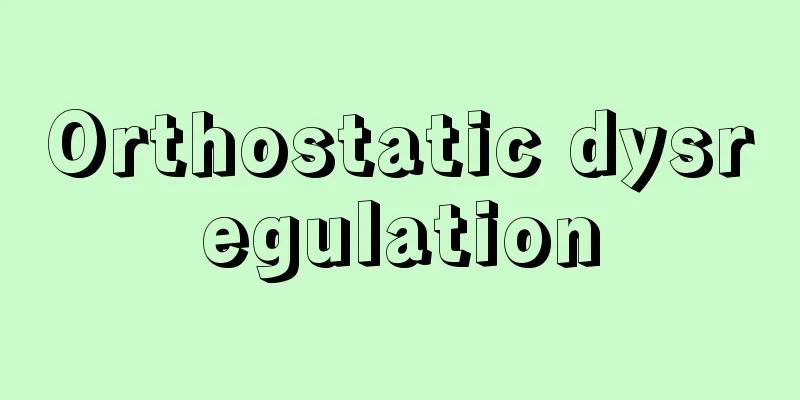Orthostatic dysregulation

|
Autonomic nervous dysfunction caused by abnormalities in blood pressure and heart rate response when standing up. Also known as OD. It is most commonly seen in adolescents (around 10-16 years old) and is accompanied by symptoms such as dizziness when standing up, difficulty waking up in the morning, fatigue, palpitations, headache, fainting, irritability, and decreased concentration. Symptoms are often stronger in the morning and improve from the afternoon to the evening. Symptoms also worsen when standing or sitting and lessen when lying down. However, in severe cases, fatigue is strong even when lying down, and patients may be unable to get up even in the afternoon or evening, which can lead to school refusal or withdrawal. If three or more of the above symptoms are present, this disease is suspected, and it is classified into the following subtypes based on the new orthostatic test. (1) Postural hypotension: A strong, transient drop in blood pressure occurs immediately after standing up, causing dizziness and lightheadedness. This is the most common type. (2) Postural orthostatic tachycardia syndrome: There is no drop in blood pressure when standing up, and orthostatic tachycardia, lightheadedness, fatigue, and headache occur. (3) Neuromediated syncope: A drop in blood pressure and ataxia occur, leading to a decrease in consciousness and loss of consciousness. (4) Prolonged orthostatic hypotension: A gradual drop in blood pressure a few minutes after standing up, causing malaise, facial pallor, cold extremities, palpitations, headache, and cold sweat. Possible causes of this disease include: (1) failure of the autonomic nervous system's compensatory mechanism for the circulatory dynamics changes that accompany standing, (2) insufficient or excessive sympathetic nervous activity, (3) insufficient fluid intake, (4) psychological or social stress, and (5) decreased daily activity. Treatment is based on the "Guidelines for the Diagnosis and Treatment of Pediatric Orthostatic Tolerance" (compiled by the Japanese Society of Psychosomatic Pediatrics), taking into consideration the severity and type of condition, as well as the degree of involvement of psychological and social aspects. As non-pharmacological treatments, (1) disease education: Explain that this is a physical disease caused by a malfunction of the autonomic nervous system, that the symptoms are not a result of laziness, and that the symptoms often improve after adolescence. In particular, parents may scold their children for difficulty getting up in the morning or for being late or absent from school, which can worsen their relationship with their children. For this reason, encourage both the child and the parents to understand the disease. (2) Treatment in daily life: Try to maintain a regular rhythm of life as much as possible, avoid going to bed during the day, and try not to go to bed too late at night even if you are not sleepy. Wake up and stand up slowly. When standing up, cross both legs or tap your feet (to prevent a drop in blood pressure). Drink 1.5 to 2 liters of water a day and consume relatively more salt. Avoid hot places in the summer and be mindful of drinking water appropriately. (3) Cooperation with schools: We ask the schools to deepen their understanding of the illness and take appropriate measures. (4) Other: We provide psychological therapy, environmental adjustments, etc. In cases where non-pharmacological therapy is not effective enough or in severe cases, drug therapy (such as midodrine hydrochloride) is considered. With proper treatment, mild cases can improve within a few months. However, severe cases involving school absenteeism often require more than two to three years for people to return to society. Mild symptoms may continue into adulthood. [Editorial Department, May 21, 2018] Source: Shogakukan Encyclopedia Nipponica About Encyclopedia Nipponica Information | Legend |
|
起立に伴う血圧心拍反応の異常に起因する自律神経機能障害。ODとも略称される。おもに思春期(10~16歳ごろ)に多くみられ、立ちくらみや朝起き不良(起床困難)、倦怠(けんたい)感、動悸(どうき)、頭痛、失神、いらいら、集中力低下などの症状を伴う。症状は午前中に強く、午後から夜にかけて軽快することが多い。また、立位や坐位(ざい)で増強し、臥位(がい)で軽減する。ただし重症例では、臥位でも倦怠感が強く、午後~夜でも起き上がれないこともあり、不登校やひきこもりの原因となる場合がある。 上記のような症状が原則三つ以上あれば本症が疑われ、新起立試験に基づいて以下のようなサブタイプに分類される。(1)起立直後性低血圧 起立直後に一過性の強い血圧低下が生じ、めまいや立ちくらみが起こる。もっとも高頻度でみられる。(2)体位性頻脈症候群 起立時の血圧低下はみられず、起立時頻脈、ふらつき、倦怠感、頭痛が起こる。(3)神経調節性失神 血圧低下と失調症状を生じ、意識低下と意識消失が起こる。(4)遷延(せんえん)性起立性低血圧 起立から数分以後に血圧が徐々に低下し、気分不良、顔面蒼白(そうはく)、四肢冷感、動悸、頭痛、冷汗などが起こる。 本症の成因としては、(1)起立に伴う循環動態の変動に対する自律神経による代償機構の破綻(はたん)、(2)過少または過剰な交感神経活動、(3)水分の摂取不足、(4)心理・社会的ストレス、(5)日常の活動量低下などが考えられている。 治療は、重症度やタイプ、心理・社会的側面の関与度合いなどを考慮しながら、「小児起立性調節障害診断・治療ガイドライン」(日本小児心身医学会編)をベースに行われる。 非薬物療法として、(1)疾病教育 本症は自律神経機能の失調が原因の身体疾患であり、症状は「怠けグセ」などではないこと、思春期を過ぎると症状は軽快・改善することが多いことを説明する。とくに保護者は、朝の起床困難や学校を遅刻・欠席するようすから、子を叱責(しっせき)したりむりやり起床させるなどして、子との関係性を悪化させていることがある。このため、本人と保護者、両者に対して疾病への理解を促す。(2)日常生活での対処 規則正しい生活リズムをできる範囲で心がけ、日中は寝床につくことを避けて、夜は眠気がなくても就床が遅い時間にならないようにする。起床・起立行為をゆっくり行う。起立中には、両足を交差させたり、足踏みを行う(血圧低下を防ぐ)。水分を1日1.5~2リットル摂取し、塩分の摂取も比較的多めにする。夏季には気温の高い場所を避け、適切な飲水行動を心がける、など。(3)学校との連携 学校側にも疾患への理解を深めてもらい、適切な対応を依頼する。(4)その他 心理療法、環境調整などを行う。 非薬物療法で十分な効果が得られない場合や、重症例に対しては薬物療法(ミドドリン塩酸塩など)が検討される。 適切な治療が行われれば、軽症例では数か月以内に症状の改善が得られる。一方、不登校を伴う重症例では、社会復帰に2~3年以上を要することが多い。また、軽い症状は成人しても続く場合がある。 [編集部 2018年5月21日] 出典 小学館 日本大百科全書(ニッポニカ)日本大百科全書(ニッポニカ)について 情報 | 凡例 |
Recommend
Mangoura
An inlet on the western side of the base of the O...
Ono [town] - Ono
A town in Tamura County in the Abukuma Highlands i...
Minamoto no Tsunemoto - The origin of Minamoto
A military commander in the mid-Heian period, he ...
Migratory locusts - Ijuuhikou
...Lachoppers that fly in swarms are called flyin...
Acrylonitrile - Acrylonitrile (English spelling)
An unsaturated nitrile. Its official name is 2-pr...
fundamental human rights
… [History of human rights in Japan] The terms &q...
A frog's unfilial piety - A frog's unfilial piety
...Frog croaking has been a point of interest for...
Ministry of Justice - Gyobushoukibe
...officials who handled the fact-finding process...
doctor philosophandi (English spelling)
...The first was the formation of modern German u...
Chin - Jaw
…A general term for marine fish of the Exocoetida...
Gonzalo Fernández de Córdoba
1453‐1515 Spanish soldier known by the nickname Gr...
"Gimon Reading Journal" - Gimon Reading Journal
…He inherited the method of seeking truth from Wa...
Navy uniform - kaigunfuku
...There are some eras, countries, and branches o...
Wood carving
An abbreviation of wooden sculpture, the opposite...
Rock surface creation - Ganmenzosei
...(3) Rocky coastal cleaning: In some cases, the...









